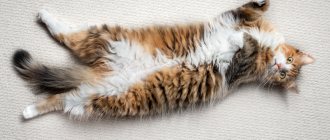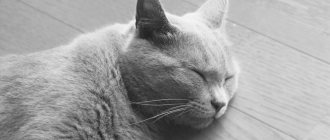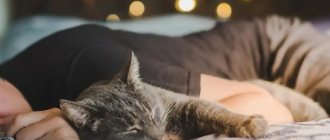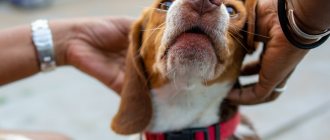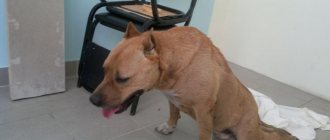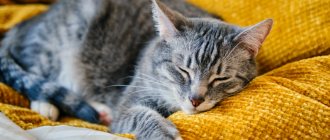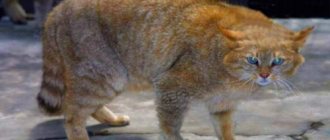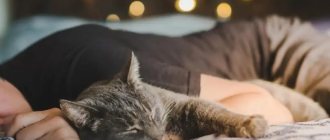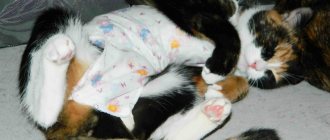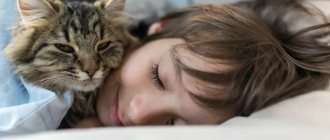All people had the opportunity to watch the cats while they dozed with their paws outstretched or tucked in. And furry predators sleep 12-18 hours a day, which is as much as two-thirds of their life! Considering that the position in which the pet lies with its belly up, legs outstretched, is considered an unprotected and vulnerable position, many owners were interested in the question - why does the cat lie on its back? Based on observations of felines, several interesting conclusions were made, which we will now introduce to you.
Why does the cat lie on its back?
Sleeping on your back: normal or pathological?
The instincts, behavior and habits of cats are in many ways similar to human ones. This applies not only to reactions and needs inherent in nature, but also to banal physical states: relaxation, tension, etc. During rest, a person can lie on his back, stomach, side, or in the fetal position. This is often due to the level of fatigue, mood, or a banal habit.
In their dreams, cats encounter different emotionally charged episodes.
Curious! Scientists conducted a number of experiments studying animals during sleep, in particular cats were experimental subjects. It turned out that they, like people, are no strangers to emotional dreams. Moreover, it was possible to decipher their contents. Mostly these are episodes of hunting, exploring the area, irritation and even fear.
They say that a cat sleeping on its back sees only good dreams.
Human and cat rest are similar in that during this time both are capable of experiencing happiness. For cats, one of the indicators of this condition is sleeping on their back. This body position is absolutely normal. There is no need to worry about the health of a kitten seen lying on its back with half-closed eyes.
Self-defense
The cat does not show its belly if it senses danger. However, at times she lies on her back, thereby demonstrating her vulnerability, but in reality, luring the victim. Anyone who falls for this trick and comes closer will be grabbed by all four paws.
If your furry friend lays down on his back immediately after an unpleasant incident, such as waking up suddenly or encountering a dog, he is likely not in the mood to receive belly rubs. Touching at this moment can provoke aggression. A twitching or fluffed tail indicates a state of dissatisfaction.
Other signs of a cat's indignation and anxiety include withdrawn ears, widened or sparkling eyes, and threatening sounds (hissing, growling). If such warning behavior is present, it is best to leave the pet alone, allow it to calm down, and return to socializing at a more appropriate time.
Based on materials from catcheckup.com
Features of cat sleep
Every average nine-year-old cat slept for at least six years! However, “overslept” is a rough definition, more like dozed off. Cats allow themselves sound, healthy sleep much less often; they spend most of their lives in the relaxation stage.
Video - How and where cats prefer to sleep
Sleep phases
Table 1. Physiological changes in different stages of sleep
| Criterion | Slow phase | Fast phase |
| Heart | Reducing heart beats | Increased heart rate, pulse may be uneven |
| Lungs | Slowing down your breathing rate | Breathing rate is variable |
| Muscles | Muscle relaxation | Convulsive movements of the tail, paws, twitching of the ears |
| Eyes | Slow fading eye movements occur under the eyelids | Rapid eye movement |
| Body temperature | Decreases (to several degrees) | Increasing |
| Arterial pressure | Decreases | Increasing |
During half-sleep, pets do not cut off contact with the outside world, but continue to receive a continuous stream of information about what is happening around them. This feature is reflected in the position they choose to rest. If we take a closer look at the position of the entire body, we will notice that in most cases the animal takes a “on the alert” position. This means that if an irritant appears, the cat is ready to jump up sharply, and then either run away or attack.
Behind the cat's apparent relaxation, combat readiness is sometimes hidden.
Light, short sleep helps predators quickly regain strength for a short period of time to do intense work before the next period of slumber.
It is impossible to stay on constant “recharging”, so cats plunge into a healthy and sound sleep at a certain moment for the full restoration of the entire body, in particular the immune system. In this case, cats do not immediately wake up in full mobilization of strength.
A cat may unexpectedly end up on its back while sleeping
You can tell that the cat didn’t just close his eyes for five minutes, but fell asleep fully by his posture. It happens that a cat falls asleep in a half-curled position, but over time it begins to toss and turn and ends up on its back, with its paws tucked or spread out. Lying with his eyes closed in this position, the cat is not just dozing - he is completely relaxed and immersed in deep sleep, being completely indifferent to external stimuli.
Is it possible to stroke your belly at such moments?
Everything here is very individual. Based on the circumstances and character of your pet.
Active twitching of the paws and antennae is characteristic of the dreaming phase. Touching at such a moment can awaken and frighten the animal, provoking a defensive attack. Also, stroking should be avoided when the pet is already at the ready with its claws extended or is trying to digest what it has eaten with pain in its eyes.
If your pet is as tactile as possible, then you can touch it under almost any circumstances. Caution should be exercised only in case of painful sensations and during play, when your arms and legs are perceived as prey.
Why does a cat like to lie on its back?
It is no secret that to sleep, animals take the most unrealistic, sometimes hanging, poses and places that are not at all suitable for this matter: radiators, trees, flower pots, the owner’s face.
Table 2. Favorite cat sleeping positions
| Popular name | Body position | |
Incognito style | The pet curled up into a ball, hiding its hind legs and muzzle. Often the ears and tail are flattened | With this pose, cats intuitively protect their vulnerable areas: the throat and stomach. If your pet often curls up in its sleep, this does not mean that it is wary and does not trust anyone, it is just another effective way to keep warm. |
Fetal position | The pet will curl up, tucking one paw. The other three are in a free position | By examining a cat sleeping on its side, you can understand whether it is left-handed or right-handed. This depends on the tucked paw, since it is a pushing one. As a rule, for left-handers, the pushing paw is the right one, and vice versa |
Horizontal version | The pet is spread out at full length, lying on its side | This position is similar to the position of the body on its back, when the animal is as relaxed as possible and immersed in deep sleep. |
Emperor style | The pet lies on its back with its paws stretched up | The most attractive cat sleeping position due to maximum muscle relaxation |
Habit since childhood
The funny pose was imprinted in the memory of predators at that stage of their life when their eyes barely opened. It is known that small kittens spend about 65% of their time in REM sleep. During these few months after birth, they are carefully licked by their mother’s tongue while the kittens bask under her warm fur.
Sleeping on the back is common for both kittens and adults.
These moments of calm and bliss are presumably stored in the pet and manifest as rare (or frequent) episodes in the cat's adult life. Returning to the “roots” allows animals to feel like carefree and happy kittens again.
Confidence
Just like for dogs, for cats, exposing their belly is a sign of friendliness. If a domestic animal is sure that it is absolutely safe, feels protected in a familiar environment with people it knows, then it can allow itself to roll over on its back and even fall asleep like that.
A cat can only allow itself such a vulnerable pose when surrounded by its closest ones.
At the same time, everything can change if new people appear around the pet. A cat, sensing an unfamiliar smell, strives, at a minimum, to protect itself with a more modest pose, wake up, or even run away to another place.
Comfort
When cats bend in a bizarre way and sleep soundly, you should not find a hidden meaning in this, call the doctor or forecast the weather. Basically, for pets, this position simply seems convenient. You shouldn’t deliberately turn them over and make them “the best way.”
Cats do not make unnecessary movements - if they have chosen this position, then it is the most comfortable
Need for affection
It is not difficult to understand what the insidious cat wants when it begins to sway and stretch, touching observers with its flexibility and grace. The animal thus demonstrates its humility and offers to immediately, before it changes its mind, gently and efficiently scratch its belly. For outsiders, displays of such emotions are rare, although in many cases it depends on the animal’s personal attitude towards people.
Sometimes the cat's bizarre pose is addressed to the owner and is a call to play
Attention! In the matter of affection, you should remain careful, since the graceful poses of a cat cannot always be regarded as an invitation to touch the beautiful. The stomach is the weak spot of any animal. For invading a cat's personal space, the punishment may be a blow with a clawed paw or a bite, which is a manifestation of a natural protective instinct. This rule of “mood” applies to absolutely everyone, both our own people and strangers, regardless of whether the cat is tamed or not.
When showing affection, be prepared for the fact that your pet may quickly change his mood
If anyone is interested in why cats roll over on their backs and pull their hands with their hind legs, then the answer is simple: this is inherent in their subconscious by nature itself. Similar behavior can be observed in the wild relatives of domestic cats: they do this to their prey, finishing it off, trying to rip open its stomach. In the case of domesticated pets, these traces of the hunting heritage remain intact.
Heat
Often it is the stuffiness that “falls” kittens onto their backs, forcing them to spread their paws in different directions, because with an open belly the body cools down faster. It is difficult for a person to understand this type of behavior, because at first glance, all cats, with the exception of some breeds, are equally fluffy in all places.
It is customary that the standard indicators of a cat’s body temperature are higher than the human norm. Even during the molting period, the fluffy coat begins to fit more tightly to reduce the air space that traps heat.
Lying on its back, the cat tries to lower its body temperature by airing its undercoat
In the hot summer, cats move to the floor even from the soft, barely occupied master's bed, because on the floor it feels cool. But such measures are not enough for cooling. Heat exchange in the abdominal area occurs faster, since there is less hair there, so cats “ventilate” by turning over on their backs.
Puberty
Discomfort in the groin caused by the desire of an uncastrated cat serves as another answer to the question that interests us. This revealing position helps ease the male's discomfort due to arousal. A person can only wait until the “March” period ends, or find a partner for the pet to mate with.
Binge eating
Tailed lovers of food and sleep have a habit of manipulating people by begging for food. Everything is used, from charisma to undisguised arrogance. Such manipulations sometimes backfire on pets: uncontrollable cat greed and boundless human generosity lead to overeating of the animal.
For overweight cats prone to overeating, sleeping on their back is the only way to rest without squeezing their stomach.
Having had enough, the pet craves only rest. And then he is faced with a problem: curling up into a ball or lying on his paws is painful and uncomfortable. Depending on the degree of overeating, he has to fall on his side or back so that nothing is squeezing his stomach.
Whenever possible, limit your pets from unauthorized access to food.
No matter how funny it may look, the gastronomic issue is not to be joked about. The owner, one way or another, takes responsibility for the one he has fed and tamed, so he must wisely calculate the proportions, making the cat’s diet balanced. If you are having difficulty weaning your pet from trying to eat the owner's food, below are some recommendations for pacifying the gourmet.
We stop the cat from begging for food
Other ailments
For a loving owner, his guests and just random passers-by, a cat resting on its back is a touching sight, a reason to take out a camera for a souvenir photo or to cuddle the animal until it recovers from sleep. Moving on to the planned actions, few people suspect about the health problems of the pet, due to which he selects this particular position.
In addition to behavioral characteristics, various diseases can also be the cause of sleeping on your back.
If sleeping on your back is a sign of illness, it will be accompanied by some of the following signals:
- the pet becomes restless;
- cannot find a place for himself;
- meows often and loudly;
- eats less often;
- cannot go to the toilet or does it too often.
If the cat behaves aggressively during palpation, then it is necessary to identify the source of pain
In this case, a visit to the veterinarian will not be unnecessary. Most likely, your pet may have:
- Digestive tract problems;
- Disease of the genitourinary system;
- Ailments in the groin and other inflammations.
Often, a sick animal does not allow itself to be touched, and when palpation is attempted, even the kindest domestic animal unexpectedly responds with aggression. You can find out more about cat diseases on our portal.
The cause of diseases associated with the inability to lie on the stomach is most often disturbances in the gastrointestinal tract.
If the cat’s tests indicate the absence of pathologies, then the reason for sleeping on the back is one or even several of the above points.
Sometimes, sleeping with their belly up, animals sniffle and even quite literally snore. This is not a symptom of pulmonary or heart failure unless the pet suffers from shortness of breath, poor appetite and inactivity when awake. Otherwise, housewives have nothing to worry about: the nasal septum in an uncomfortable position is slightly depressed, as happens in a person during snoring.
Does sleeping position depend on the breed?
This is not to say that there are unique breeds that have a special attitude towards sleeping on their back. Having excellent health and getting enough pleasure from life, both the Sphinxes and the British behave the same in this regard.
Don Sphynx curled up into a ball
The only thing that influences a cat’s choice of resting position is the density and density of the fur. Under favorable conditions, cats with different coats may feel differently. The one with sparse and small fur will most likely fall on his paws or curl up in a ball, but a cat with longer and thicker hair will fall asleep on his side or roll over on his back.
